How I’m Learning Chinese as a Busy Parent: Speaking, Reading, Writing
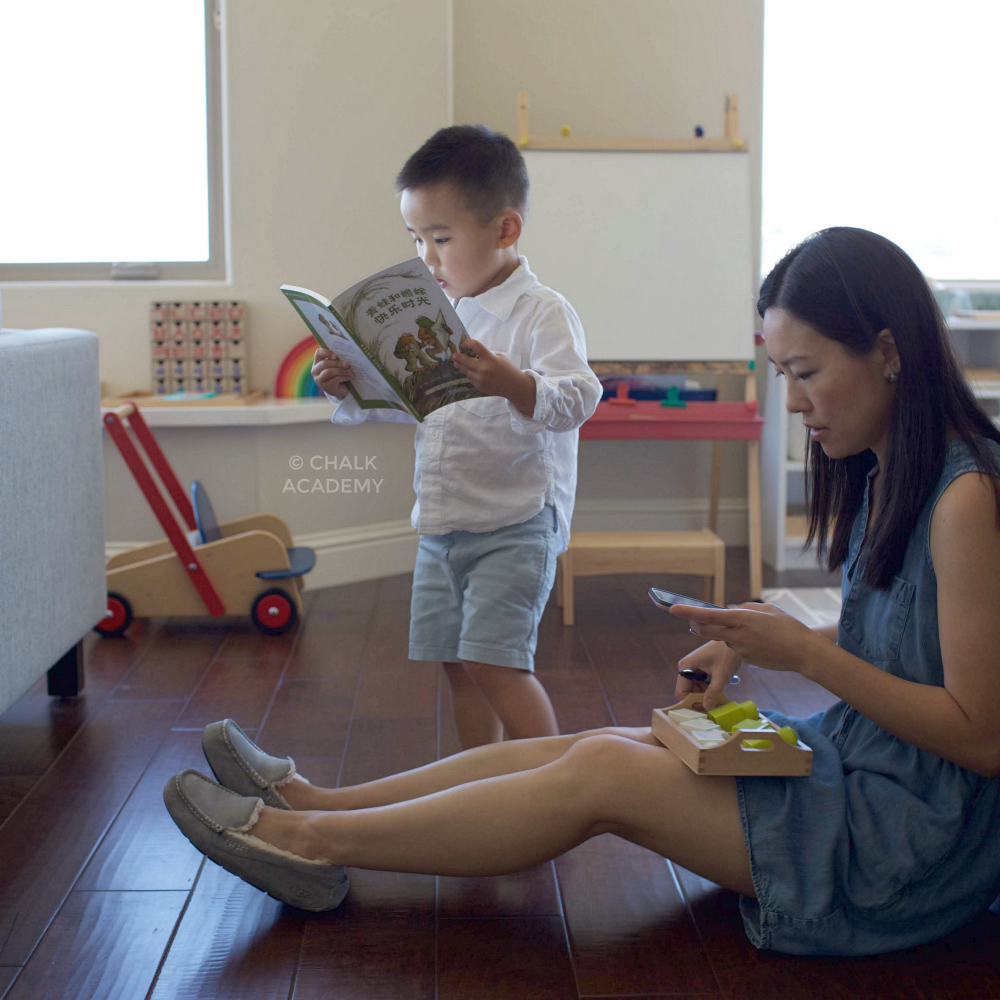
Kids have a funny way of changing your goals and priorities. After a lifetime of avoiding my heritage language, I have been determined to re-learn Mandarin for them. Learning Chinese as a busy parent is not easy, but it’s doable and can even be fun.
If you’re in a similar situation, I hope to reassure you that it’s never too late to learn Chinese with your kids.
Even if you’re starting from scratch.
Even if you can’t travel to Asia.
Even if you’re like us – the only bilingual family in the neighborhood.
You can learn how to understand and speak Chinese. You can even learn how to read or write Chinese. You can decide how much or how little to learn.
I first wrote this article in 2017. Since then, Chinese resources have multiplied and improved. I’ve updated this guide with what’s stood the test of time.
Challenges with learning Chinese before parenthood
Although Chinese was my birth language, I completely forgot it.
Growing up, my parents spoke a mix of accented English, Mandarin, and Chinese dialects. My father often code-mixed Shanghainese and Cantonese while my mother was nostalgic for Changshahua, her native tongue.
By Kindergarten, I spoke to my parents exclusively in English. As the only Chinese family in my elementary school, speaking English was a survival instinct, a defense mechanism from bullying.
After my parents passed away in my 20s, I rarely heard their language. My husband does not speak Chinese. None of my Chinese relatives live in the United States, and I only use English at work.
6 Steps to learning Chinese as a busy parent

In this photo, I had just started to learn Mandarin with my toddler.
When I first began to learn Chinese, I had low expectations. Extremely low.
In a couple of years, I went from saying a handful of words in the wrong tone to holding most conversations with my children in Chinese.
After a few more years, I went from being illiterate to reading first-grade-level Chinese chapter books like 小熊 Little Bear.
Momentum came gradually with patience and consistency. Yet I am constantly humbled by how much there is to learn.
I share my experience to help you feel empowered and equipped to start your journey of learning and teaching your child Chinese. This is the guide I wish I had from the start. Below, I break down the process into 6 key steps.
Step 1. Know your why
Before committing to learning Chinese as a busy parent, you need to dig deep into your motivations. Yes, the cheesy, touchy-feely stuff.
- Why do you want to learn Chinese?
- Do you want to communicate with relatives?
- Do you want your children to communicate with relatives?
- Are you trying to connect with your heritage?
- Are you learning just for fun or curiosity?
Jot down your thoughts in a journal or notes app. A visceral “why” can carry you through Chinese learning challenges of which there will likely be many.
Read this: A Letter to My Parents: Why I’m Teaching Your Grandchildren Chinese
After my first child was born, the absence of my parents felt larger than ever before. I had a hard time remembering my parents’ advice and stories because much of it was told in a language I had forgotten. To connect my children to the memory of my late parents, I felt desperate about learning Chinese.
Because we had no local support for this language, my children’s chances of growing up bilingual depended on me.
Step 2: Learn Chinese at your own pace
Since publishing this post a few years ago, many Chalk Academy readers have shared far more impressive stories. There will always be people who have more time, talent, travel opportunities, and community support.
While celebrating their success, I remind myself not to compare. I am learning Chinese at my own pace.
Learning a second language is not for everyone. You might even discover that it’s not worth it for your family. A few years ago, we dropped another language, Korean. After a long work week, my husband has no time or energy to speak his minority language, Spanish.
Remember, it’s a marathon. Endurance comes from moving at a pace of grace.
Step 3: Get support from fluent Chinese speakers
Once you’ve gotten in touch with your sensitive side and established your motivations, it’s time to take action. The next step is to get support from native Chinese speakers.
1:1 Chinese tutoring
With the help of a fluent Chinese teacher, you can get the most personalized learning.
In-person lessons have the benefit of body language to aid verbal communication. If this is not feasible due to your location or schedule, iTalki and Preply have made online Chinese tutoring very accessible and relatively affordable.
What makes a good beginner Chinese class? Lessons should be filled with interactive conversations that gradually build confidence and high-yield vocabulary. Run away from teachers who rely on passive videos and PowerPoint presentations.
Remember that you don’t have to commit to lessons forever. You can pause and resume as your schedule permits. In the last several years, I have only had occasional online tutoring due to my saturated work and parenting schedule.
Bilingual childcare
If your budget allows for childcare, a bilingual nanny, au pair, or regular babysitter can be a wonderful friend in your family’s learning journey. Learn how to find a language caregiver/teacher for your child here.
Unfortunately, this was not an option in our non-diverse location. I searched high and low for Mandarin-speaking nannies and babysitters in our area with no luck. We also have no space for a live-in caregiver.
FaceTime with Chinese-speaking family and friends
It might be odd to consider family phone calls as “Chinese language practice”. Technically, talking in any language is a practice of being bold and expressing yourself. And it can be a wonderful chance to connect on a deeper level.
Currently, my favorite Mandarin practice includes calling my dear Auntie on my way to work.
Since we spent the last 3 decades communicating in English, it was initially hard for Auntie to switch to speaking Chinese, her native language with me. She would worry that I couldn’t understand her; admittedly, I still have to check the dictionary here and there.
Over the years, these daily calls in Mandarin have helped us communicate better, especially as she has forgotten a lot of English with her old age.
Step 4: Focus on Chinese listening/speaking skills
If you’re a busy parent, there’s a good chance that you’re feeling overwhelmed, so don’t worry about reading and writing. Listening and speaking are foundational language skills. Many tutors encourage an all-in approach, but if you’re like me, you might need to take things step by step.
- How do you start talking in Chinese? One word at a time. One sentence at a time.
- What words should you learn first? If you’re learning Chinese as a busy parent, the most high-yield words are related to your daily routine. This includes common greetings, basic needs, body parts, and your child’s interests.
Here are the best resources for learning your first Chinese parenting words.
Mandarin Chinese Parenting Phrasebook
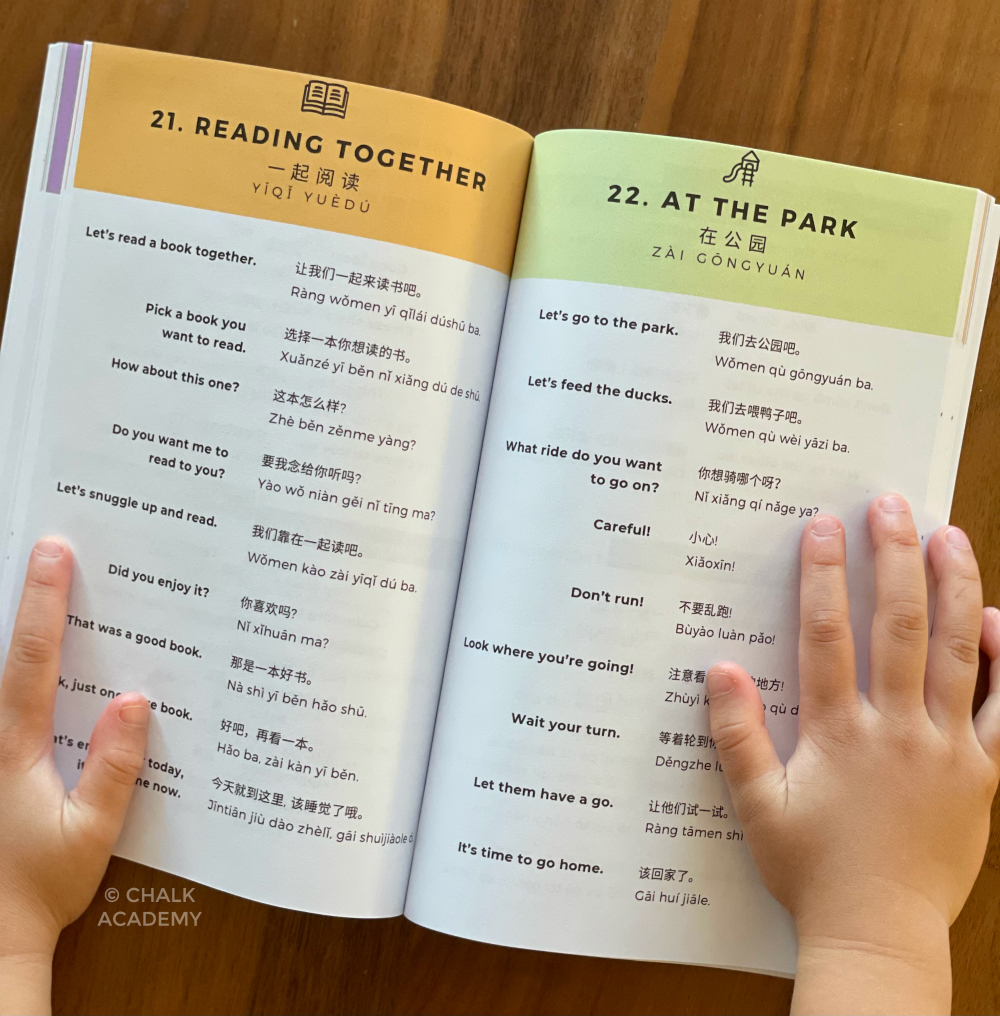
This book has 1,500 common parenting phrases organized by topic. Free audio narration in Mandarin and Cantonese on the author’s website.
Chinese dictionaries for parents
Dictionaries are going to be your best friend on your Chinese learning journey. While Google Translate is convenient and decent, there are often errors in Pinyin, grammar, and translation.

What you need is the Pleco app which was specifically designed for Chinese learners.
Pleco is known for accurate translations and pronunciations; each definition is accompanied by example phrases or sentences. Bookmark Chinese words for future review, organize saved words by category, and make your own flashcards if you’re a flashcard learner.
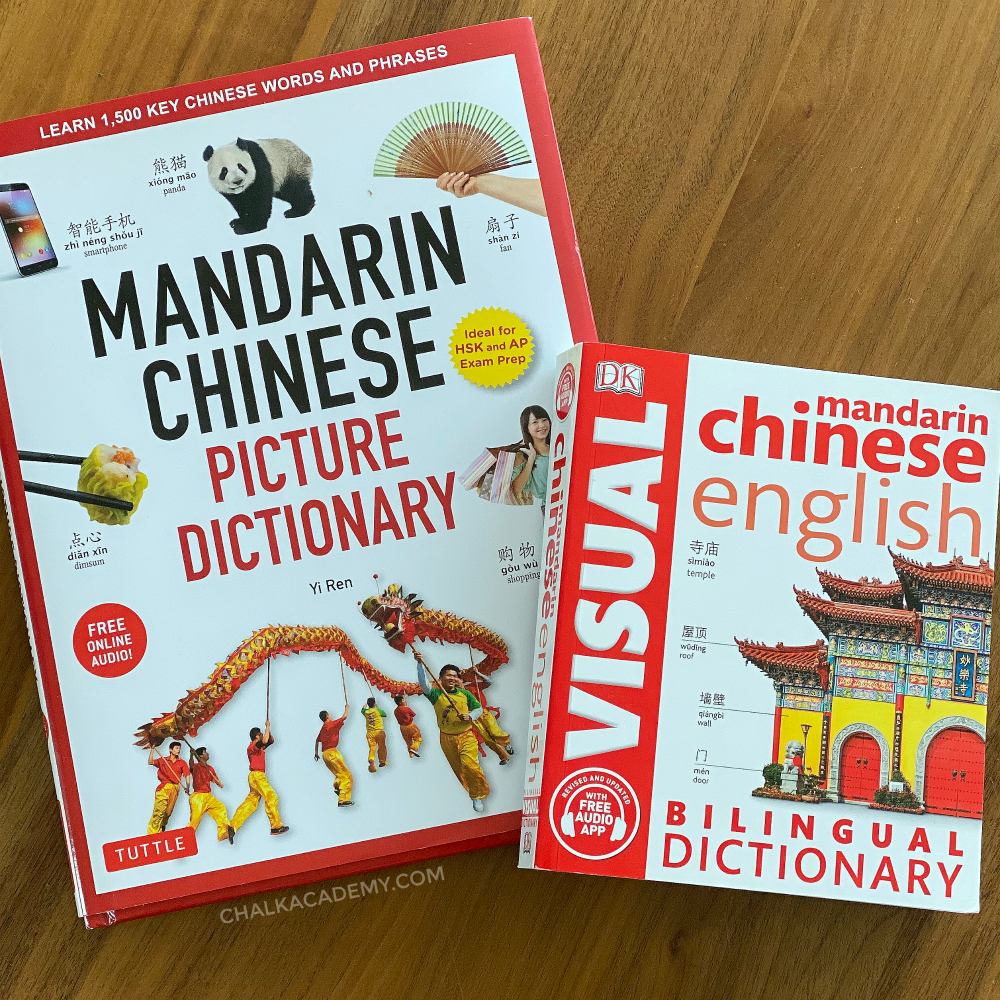
I love Chinese picture dictionaries because I can share them with my children. If you’re a visual learner, seeing real photos next to Chinese words can help!
Chinese children’s music and shows
I’ve learned so much Chinese parenting vocabulary through children’s music, shows, and books. Here are the best Chinese learning resources for busy parents.
Mandarin Chinese songs for kids
When I first began to learn Mandarin, Chinese nursery rhymes and songs were my main study tools.
For starters, the four Mandarin tones were confusing, especially since I grew up hearing different Chinese accents. The good news is that when you sing, you don’t have to worry about tones!
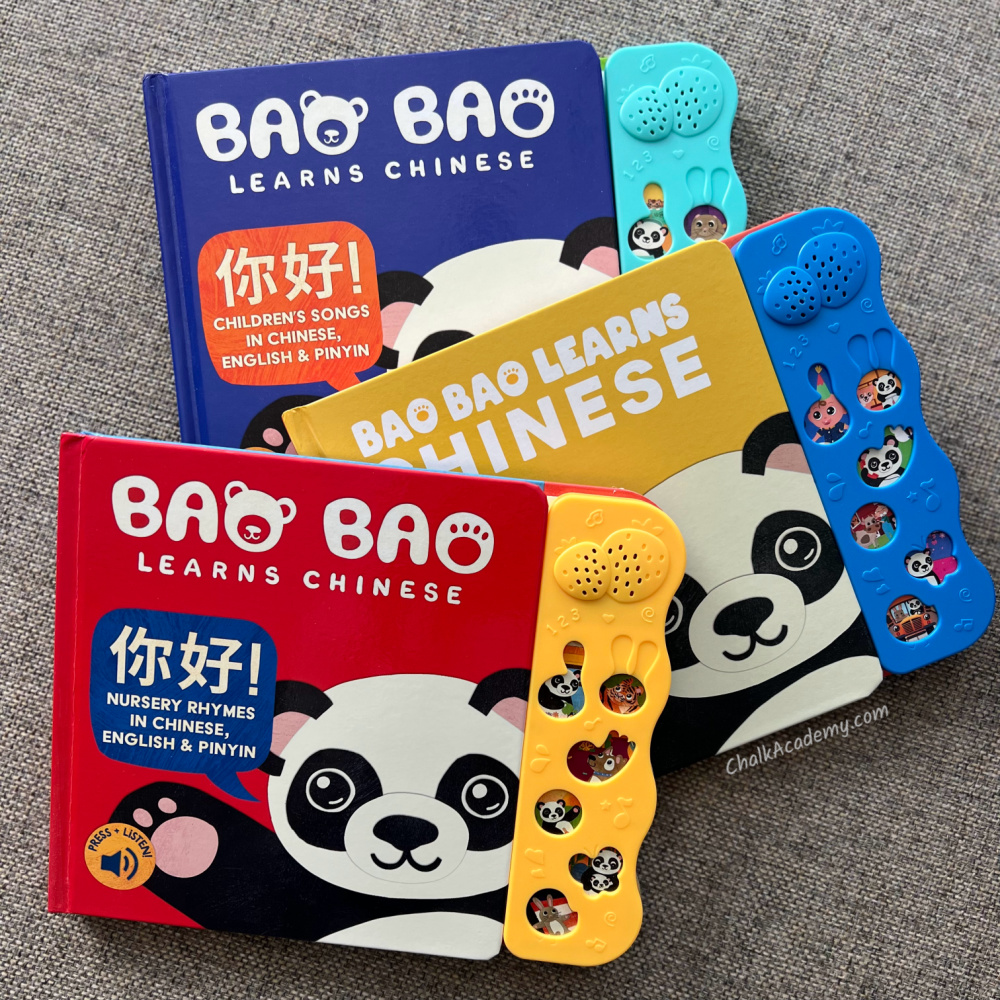
Although the BaoBao Learns Chinese music book was designed for young children, they are also perfect for grown-up beginner Mandarin learners! Each book features popular nursery rhymes from Chinese and American culture.
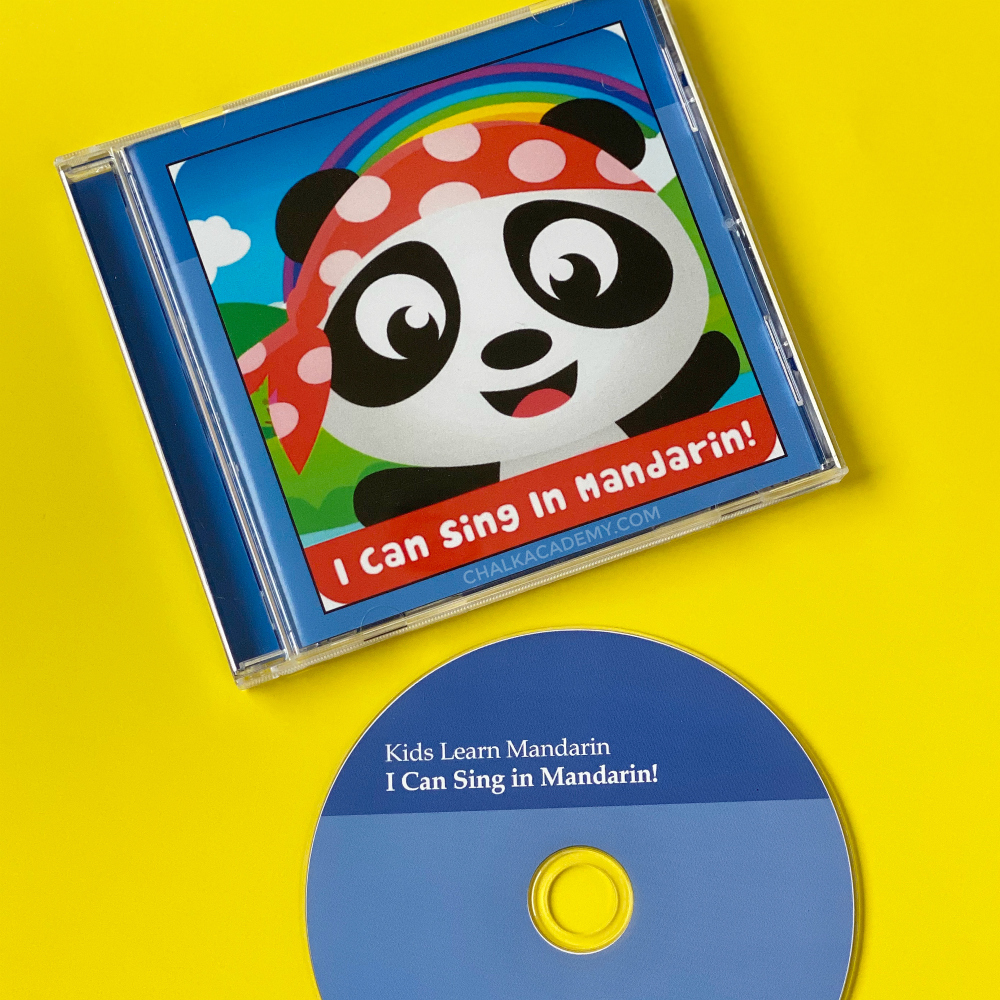
The I Can Sing in Mandarin album is fantastic for teaching everyday vocabulary such as family members, food, and body parts.
Slow Mandarin Chinese shows
While most adult learners indulge in Chinese dramas, I prefer kid-friendly shows with slow-paced talking.
The videos I “studied” are no longer available. However, these popular Chinese YouTube shows for kids can help busy parents learn common words and phrases.
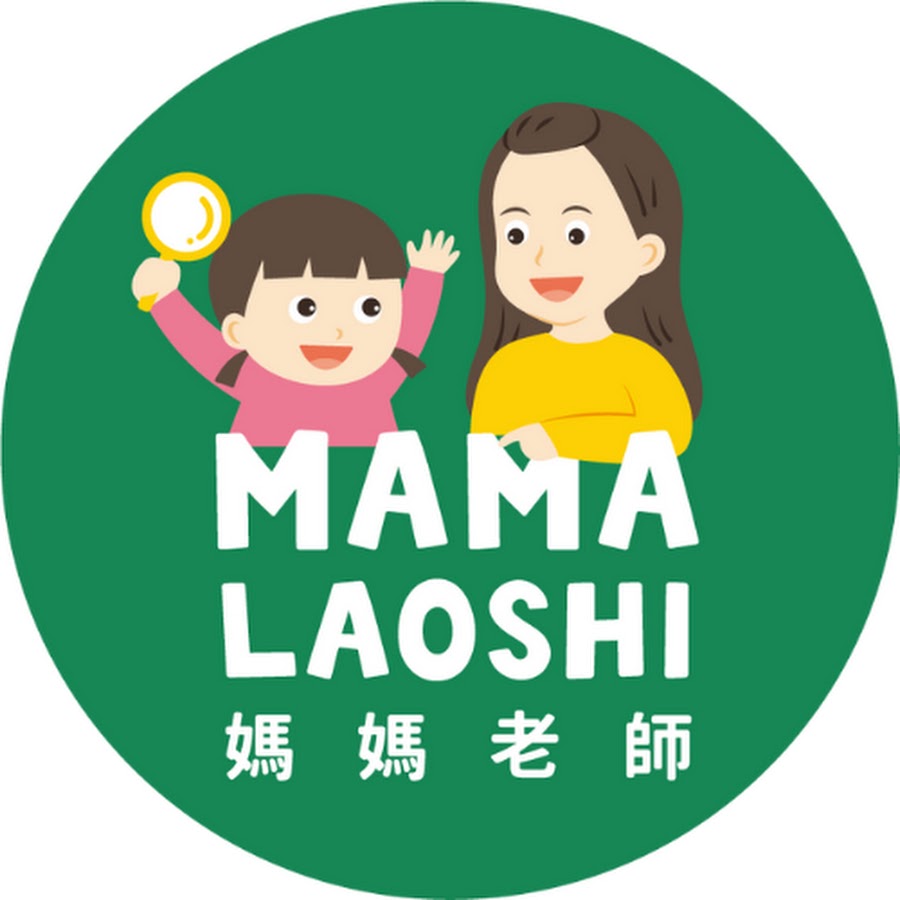
Mama Laoshi 妈妈老师 / 媽媽老師 (Māmā lǎoshī) is a Taiwanese American mom who makes the best videos with the children.
Although Chinese cartoons are cute, I highly recommend watching shows like Mama Laoshi. Videos with real people show verbal and nonverbal communication.
If you’re conversational in Mandarin and looking to improve your parenting fluency, check out these resources for intermediate to advanced speakers:
- Henry羅寶鴻 老師 Henry Lo is a Taiwanese Montessori teacher with gentle positive parenting tips. For example, he will advise parents on how to promote independence while kids are struggling through new skills, such as peeling a banana.
- 王宏哲教養育兒寶典 This popular Taiwanese pediatrician gives health and parenting advice, such as healthy sleep habits.
Practice, practice, practice
In order to get better, you have to talk. One word at a time – every word counts.
Even if you’re thinking “I don’t know that many Chinese words”, each of those words are still valuable to share with your kids.
Put it on your planner, and set reminders on your calendar.
When my friend just started her family’s Mandarin parenting journey, she reminded herself to 说中文 (shuō zhōngwén / speak Chinese) with this reminder on her wall.
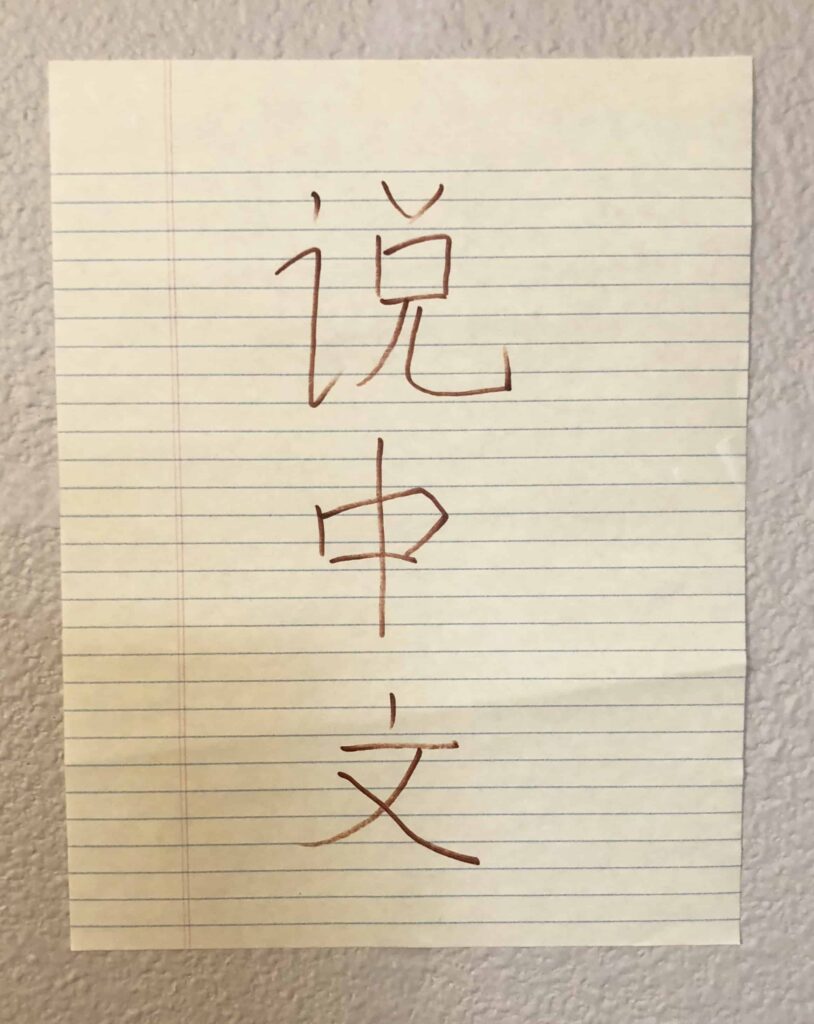
Step 5 (optional): Learn Chinese characters
If the first few steps are daunting enough, pause here. Bookmark the rest of the article for future reference. You’re a busy parent, you’re learning Chinese, and you’re doing more than enough!
But…if you’re curious about the possibility of Chinese literacy, keep reading.
Know your why
In the beginning, I never wanted to read Chinese. I just wanted to focus on understanding and speaking Mandarin. Chinese characters were so intimidating and made my head explode.
Later, what motivated me to try was the dream of being able to read Chinese books to my children. I also wanted to be able to understand texts from my favorite auntie.
Hanyu Pinyin and Zhuyin Fuhao
I’m so glad that a tutor convinced me to start with the phonetic alphabet. The phonetic options are Hanyu Pinyin or Zhuyin Fuhao, and that depends on whether you choose simplified versus Chinese characters (read more here).
Check out Yabla for their pinyin audio chart, and MDN Kids for their zhuyin audio chart.
Related: When Should My Child Learn Hanyu Pinyin?
Post-It notes
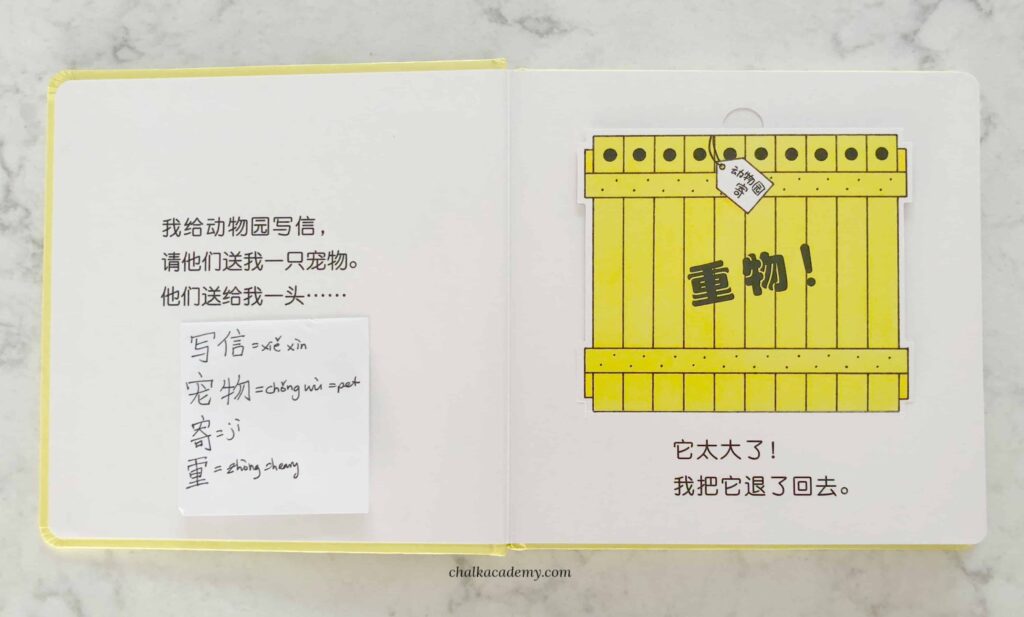
Eventually, I decided to learn how to read Chinese characters. Though it’s taken a few years, and one of my children quickly outpaced my abilities, it was worth trying. I’ve been able to read cute books with my kids and menus at restaurants.
By now, you might be surprised that I haven’t recommended any textbooks, flashcards, or workbooks. Spoiler alert: I’ve tried several and found them to be inefficient for my goal of learning Mandarin as a parent.
Instead, I learned how to read Chinese through children’s books, Post-It Notes, and dictionaries.
When my children were little, I studied Chinese baby board books and short picture books during my lunch break and at night. Sometimes, I would study next to my kids if they were playing independently.
On Post-It notes, I wrote unfamiliar Chinese characters as large as possible. On the back of the Post-It note, I wrote the phonetic Pinyin and English translations as small as possible.
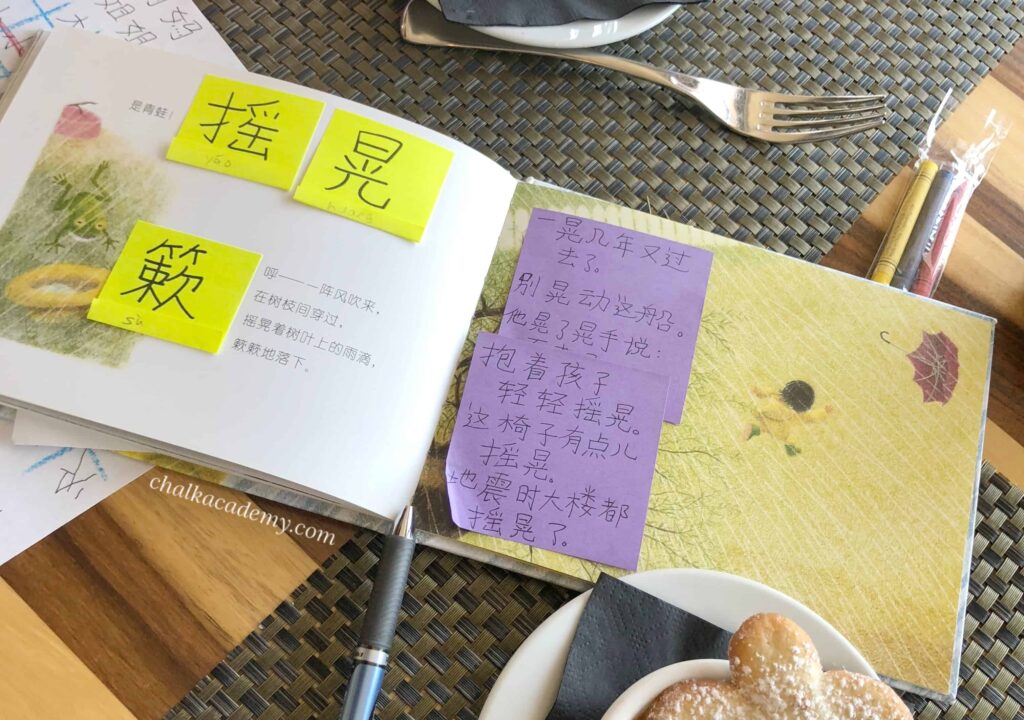
Chinese children’s books and gadgets
Nowadays, busy parents learning Chinese are lucky! There’s been an explosion of resources that can make the process less tedious than what I experienced years ago.
I recommend jumpstarting the Chinese reading process with the following books.

Bilingual Chinese Picture Books with Pinyin and English are great for reading practice. When your child sees you reading, they might even peek over your shoulder and get curious about reading!
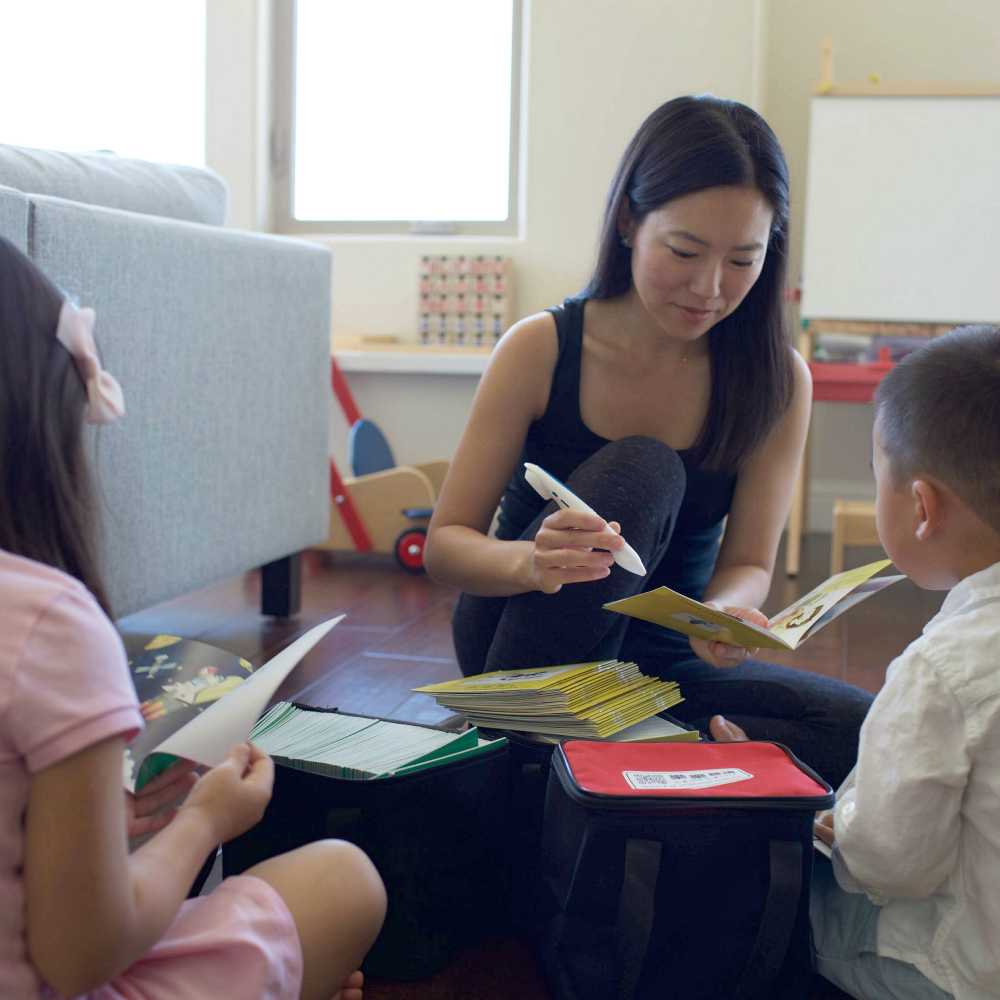
乐乐 / 樂樂 Le Le Chinese Reading Pen Book Set comes with 300 books on various topics with realistic illustrations. This series is a splurge but a worthwhile investment for most non-fluent families.
If you’re further along in your Mandarin learning journey and feeling passionate about reading, these two gadgets can be a big help:
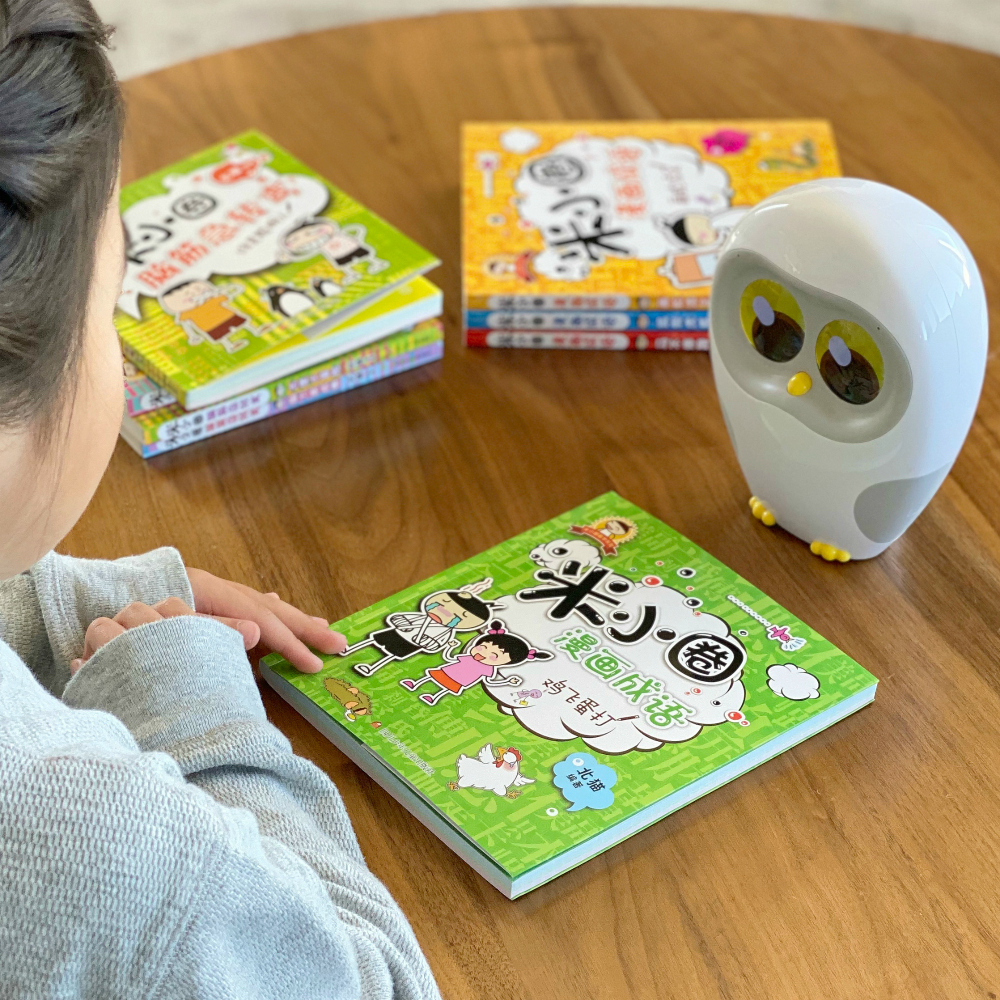
Luka Reading Robot can narrate picture books in Mandarin. It’s basically an audiobook player that’s synced to thousands of popular Chinese books! This is my family’s absolute favorite gadget. Love, love, love.
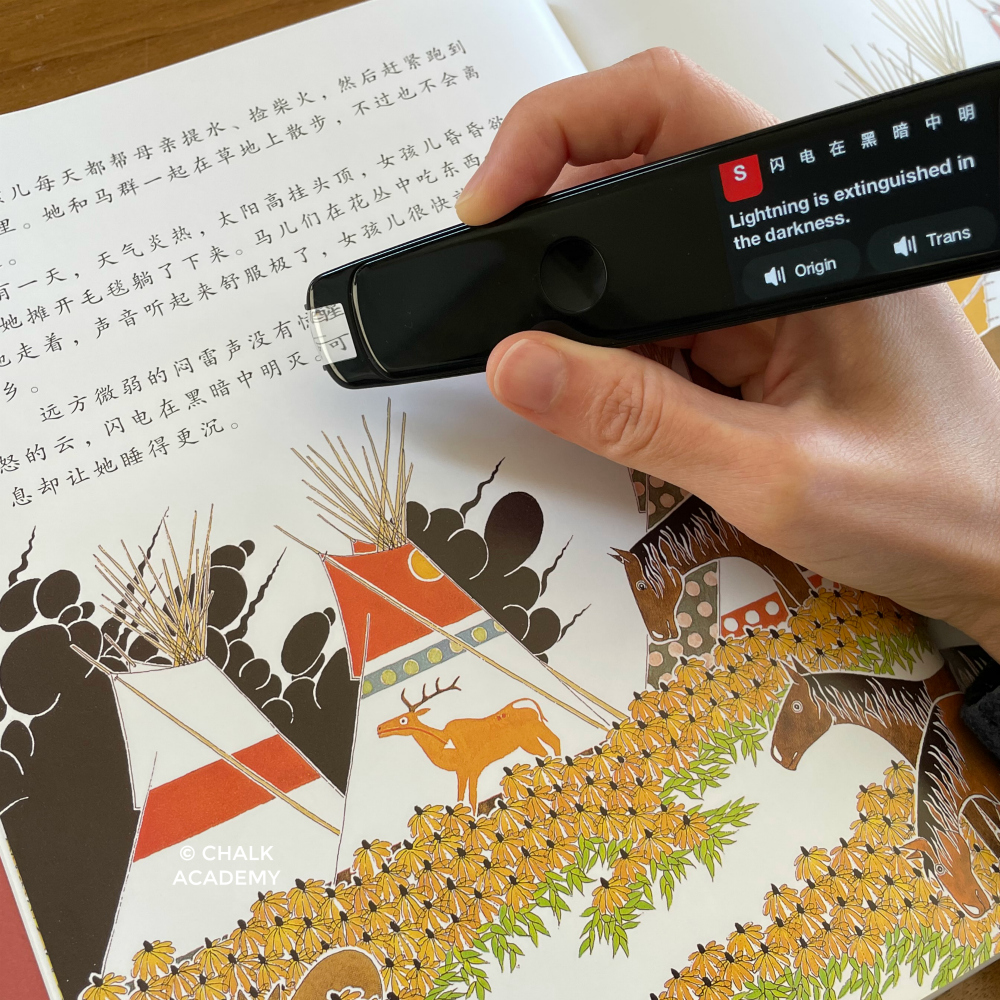
Youdao dictionary translation pen can help parents look up words on the fly. Out of habit, I reflexively check my Chinese dictionary apps. However, I share this tool since many Chalk Academy parents prefer this translation pen.
Chinese labels = visual reminders
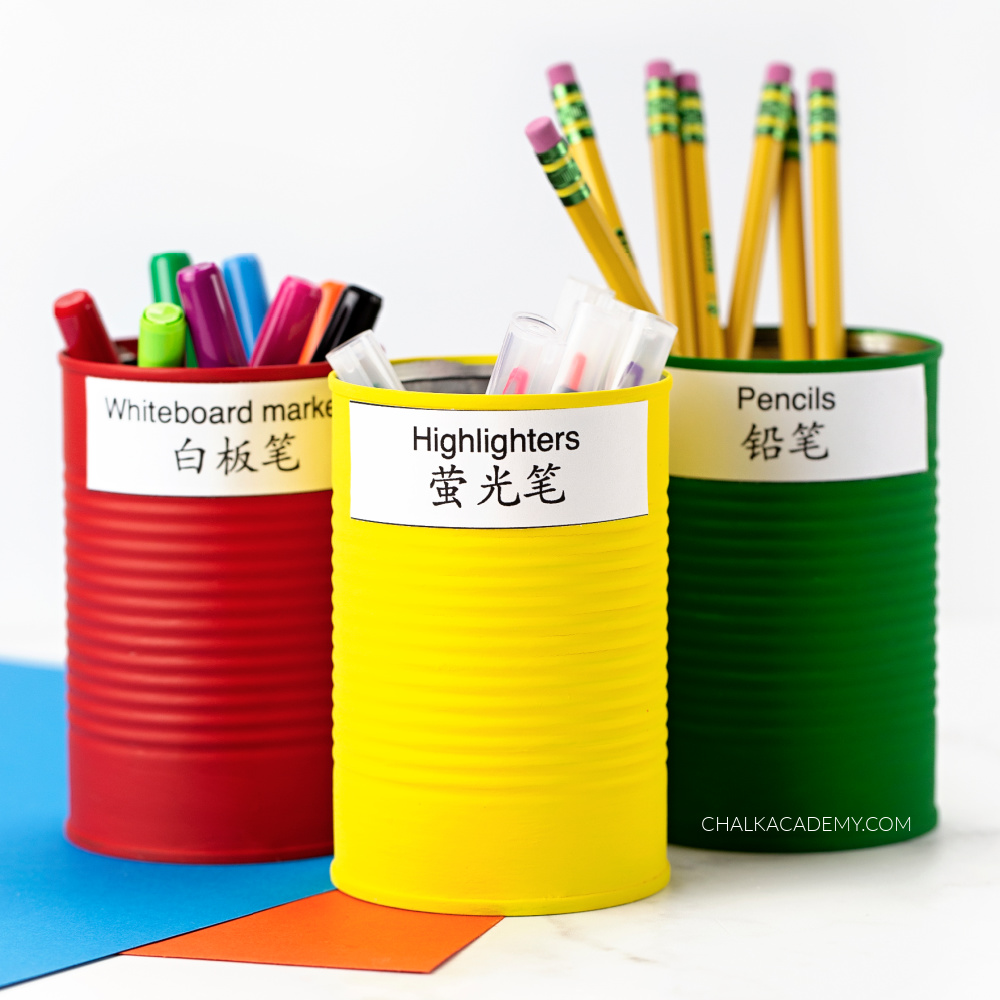
Chinese labels have been an integral part of normalizing the language in our home. Ever since my kids were little, we’ve had Chinese words all over our house.
Now, when my children’s friends come over, they might think it’s a bit odd, but we’re trying to normalize bilingualism over here! And it works.
You can see more examples and tips about how we label our house here.
Step 6 (optional): Learn how to write Chinese
Skip this section if time is tight. In my humble opinion, the modern world of typing and texting weakens the practicality of Chinese writing. For second-language learners, Chinese writing is not a necessity.
But if you want to go all out on Chinese learning, writing can be a rewarding challenge.
Know your why
Consider your long-term goals. Do you want to want to write notes to your children? Are you interested in Chinese calligraphy? Do you want to write a journal or essays in Chinese?
When my children were younger, I was more ambitious about learning how to write Chinese. Lately, as life has gotten busier, my goals have simplified. These days, I’m happy with the ability to copy basic Chinese strokes so that I can write notes to my children.
Chinese writing app

If you’re serious about learning how to write Chinese, Skritter is a popular Chinese writing program that uses spaced repetition to help learners read and memorize Chinese characters.
Confession: Over the years, I have paid for the subscription twice. However, I’ve never been motivated to use it. Still, I share it because it’s recommended by many Chalk Academy parents.
Write special games, messages, and stories
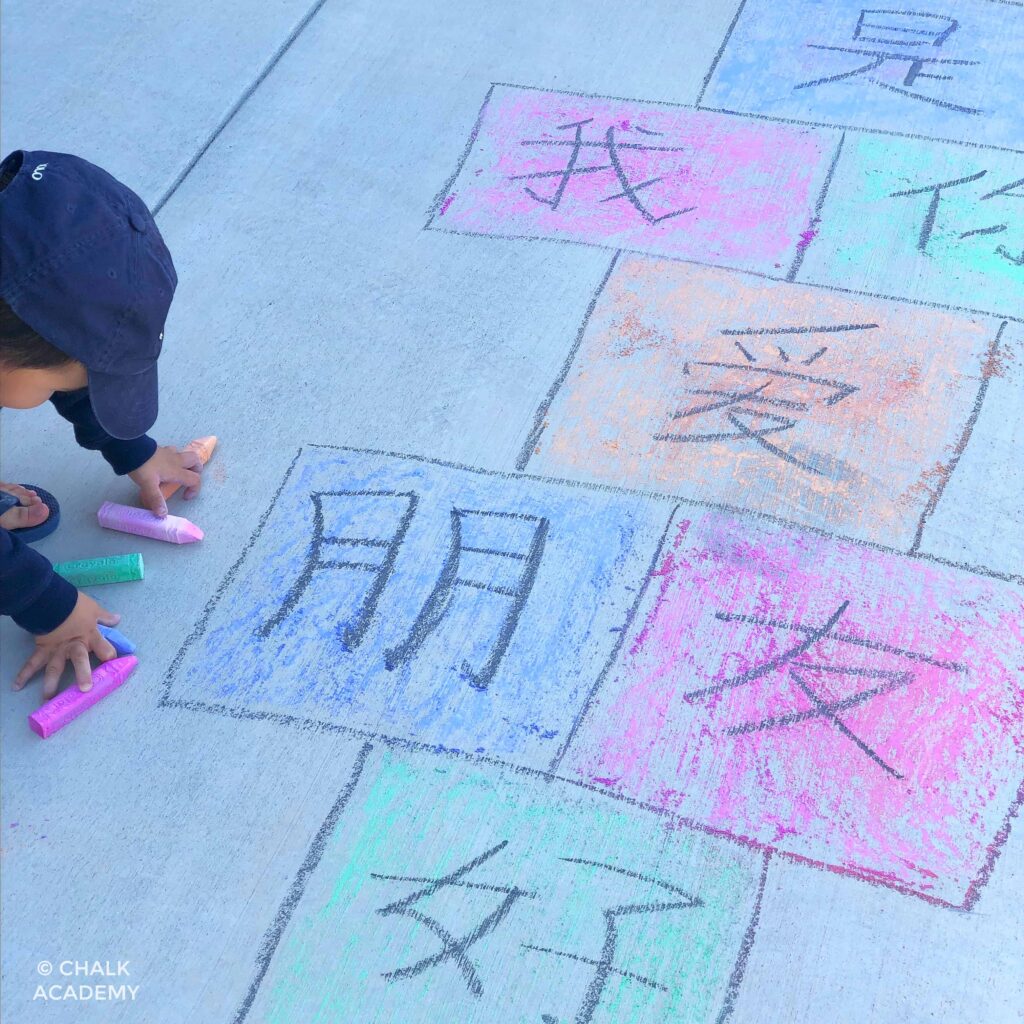
This was my favorite way of practicing Chinese writing.
My handwriting got better after copying countless phrases from the Chinese dictionary. I used to make up tons of games, such as hopscotch and other sidewalk chalk activities.
At one point, I even wrote short stories! It was so time-consuming, but these personalized notes were so exciting to my children.
Here is a video of my daughter when she was 3 years old. She’s reading a story I wrote about our weekend trip, and my beginner writing included some grammar mistakes.
I share this example because you have to be comfortable with “messing up”. If I waited until perfect fluency to write, I never would have written anything. I never would have improved.
Fast forward to today, other than labels on their lunch containers, I rarely write anything in Chinese! Parents often feel guilty for peeling back on past efforts. But life happens, and we have to adjust our plans accordingly.
Final tips for busy parents learning Chinese
Below is a super unflattering photo from a few years ago. I had no time to shower, my hair was in a greasy ponytail, and I was wearing the same clothes as the prior day.
Clearly, bilingual parenting is NOT a glamorous journey. But it can potentially lead to special connections in your family.
Set small and specific goals.
Be flexible and give yourself grace.
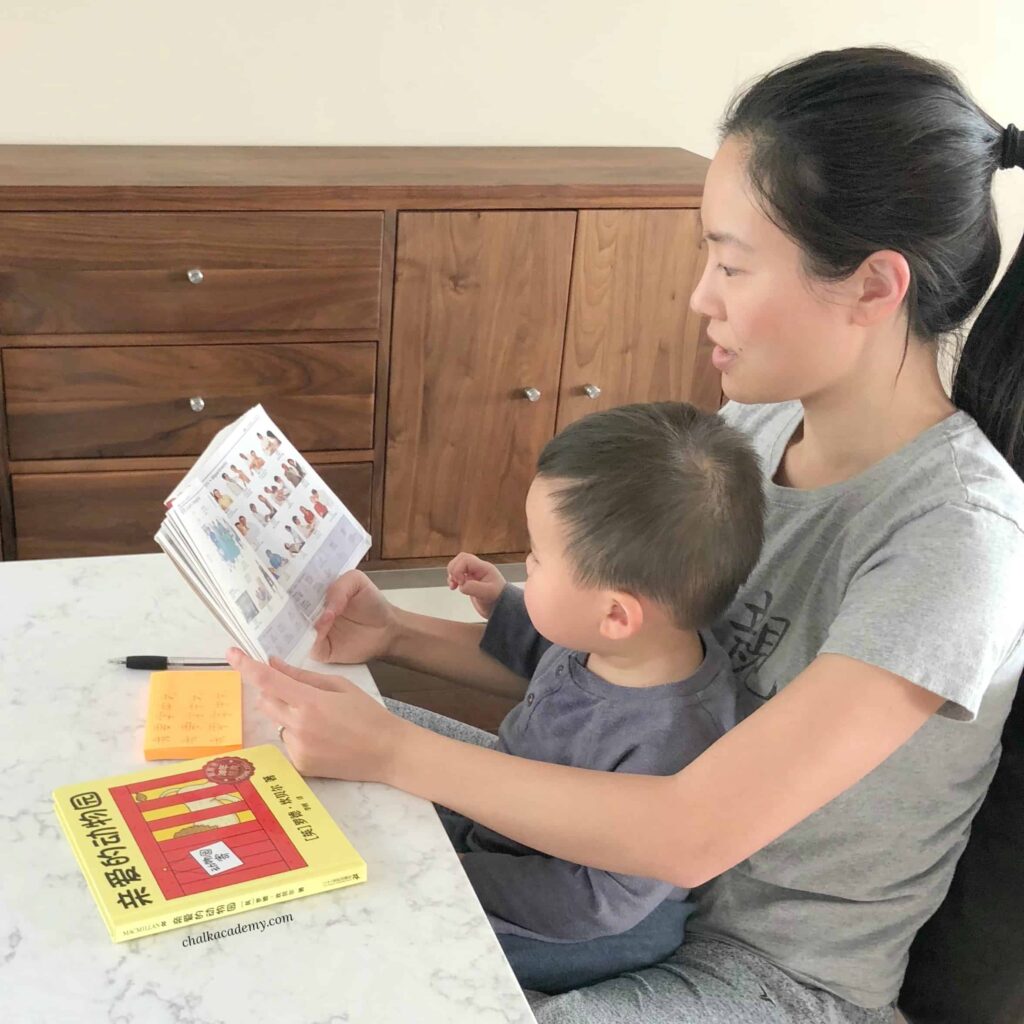
Remember that you can start, pause, resume, or stop at any time. Just like anything else, learning Chinese is not for everybody. My husband can relate if it’s not your cup of tea! You’re still an amazing parent.
Are you a busy parent learning Chinese with your child?
How is your learning journey going? What have been the biggest obstacles? What other resources that you recommend?
I’d love to learn more about your experience. Please feel free to share in the comments!
JUMPSTART GUIDE TO
TEACHING KIDS CHINESE
7 Days of Practical Tips Delivered to Your Inbox from Dr. Betty
CHALKACADEMY.COM

I love all the resources but some are not available anymore which was a huge bummer (I wanted that red book and cd), I am so overwhelmed with all the resources and trying to figure out what works and if I continue. Sadly I know I can currently try harder and teach my kids but like you said, it is a huge endeavor and not glamorous or fulfilling immediately, it is such a slow process and I actually can speak first grade Mandarin and really should speak to my kids more but it’s so much easier to turn to a English instead. I am in some Facebook groups but kinda like you said the compare snare makes me feel like my own journey is way behind and slower and I just am trying to figure out how to keep helping them. I know it doesn’t matter either way and at least they know something but I can’t help but want to do more and then not, and then want to again! Hahaha. I will check back to see if some of these resources become available but I appreciate you putting it all together!! Thank you, this is seriously so so helpful and inspiring!
Thanks Betty for your inspiring blog. I stumbled on it accidently today as I was feeling a big discouraged after my 6 year old’s mandarin lesson and wondering how I can help improve her mandarin.
I have two kids (6 and 4) and my parents speak cantonese and I went to Mandarin lessons on Saturday when I was young but not fluent in Mandarin. Your blog has inspired me though. I’ll take up the challenge to learn and speak Mandarin to my kids and see where this journey takes us.
I just wanted to say how much I loved watching the video of your little one read Chinese! So impressive! Your site has such great resources, and I appreciate all of it. I have a very verbal 21-month old right now who is already using full sentences in Chinese, so I know it’s going to be a struggle in the coming years keeping up with her (I’m already struggling with vocabulary). We are starting to introduce characters to her at the same time as her ABCs, and I need more mandarin books for our library, both for her and myself since I can’t really read.
Thank you so much for taking the time to write! Ahhh can’t believe that video is more than 3 years ago now! Your little one sounds like she is growing up quickly, too! 🙂 That’s so great that she’s already speaking full sentences in Mandarin! I hope you can find some great Chinese books to enjoy and learn together! Please let me know if I can help with anything!
Seeing the progression of your conversations with your daughter over the years is giving me hope! My husband is Korean and I am trying to speak Korean to our 2-year old son, even though my language level is quite low. I read the books very, very slowly… but I am reading them! I like the idea of pre-studying it. My husband is our language tutor :P. Our house has post-its are everywhere, haha. Anyways, this made me feel a little better about not being fluent yet, but still trying! <3
Hi Amanda! Thank you so much for sharing your experience! I’m inspired that you are learning Korean with your son, too! Chinese is still a gradual process for me and I’ve learned to be okay with not being 100% fluent. Pre-reading the kids books definitely helps! Glad we aren’t the only ones with Post-It notes everywhere! 🙂
Is there any chance that you can update the link for the Mandarin Chinese reading pen set? Thank you for being such an amazing resource!
Hi Diana! Thank you for letting me know about the link! I’m so sorry, I just checked and it seems that that Chinese reading pen set is no longer available. However, I would recommend looking into the 乐乐 / 樂樂 LeLe Chinese Reading Pen Book Set. I just began the traditional Chinese version with my daughter today, and I wish we had it 3 years ago when we were just starting out!
I’m new to your blog, but I can stop reading! Thank you for all the time you’ve put into the activities and the research! It’s pretty much all I’ve wanted to look for but never had enough time to filter!
Thank you so much for taking the time to read and comment! I really appreciate it and hope that the information can be helpful for your family!
great post! Such helpful tips. I’m going to go label things in my house now hahaha
Thank you Sunny! Haha have fun labeling your house!
As the non native speaking parent I’ve always felt my very busy husband was failing in his responsibility of speaking Chinese to our daughter. Even though I can speak chinese (albeit very flatly and not very fluently) I had been to.. nervous or shy to speak with my daughter for fear she’d learn my clumsy chinese so I stuck to reading her mandarin books everyday instead. After reading this post yesterday I started speaking Chinese to her when I could. Suddenly she told me she likes hearing me talk Chinese and now she’s using some back. Even better, it’s causing my husband to feel guilty and now he’s using more chinese with her too. I hope we can keep this going! Thanks for the encouragement.
Hi Emi, thank you so much for sharing your story. I’m glad to hear that this post has helped to motivate you to speak more Chinese, even if it’s not as fluent as your husband! So glad to hear that your daughter’s encouraging reaction!